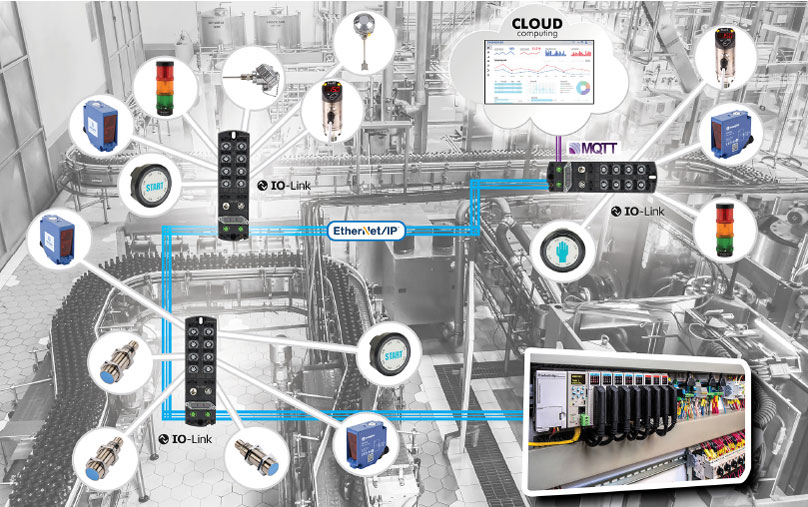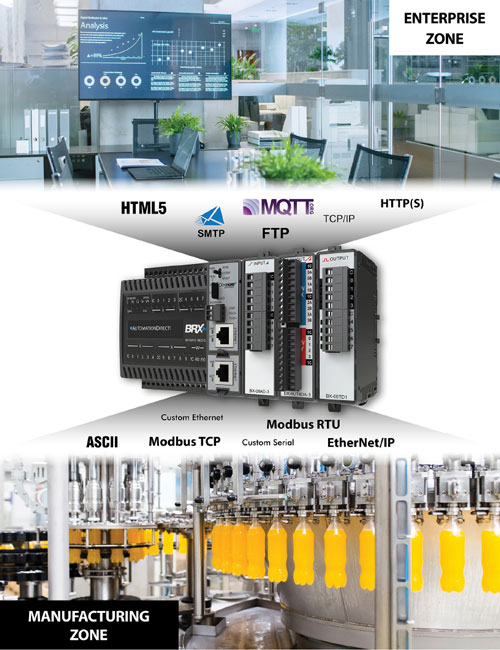- By Bill Dehner
- May 01, 2023
- IIoT
Summary

Start incrementally at the edge by combining proven fieldbuses and controllers.
Basic hardwired connectivity of sensors and instruments has been a typical automation system design for manufacturing sites and original equipment manufacturers (OEMs) for a very long time. Hardwiring is straight-forward, reliable, responsive, and well understood—even if it is a bit cumbersome.
This “keep it simple” hardwired approach is still appropriate in many cases, but three drivers have been shifting user preferences toward wireless digital solutions:
-
Smarter instruments
-
Widespread use of fieldbuses and industrial protocols
-
An increased need to access edge-located data.
When integrated well, these three concepts provide signaling equal to or better than traditional methods but with many valueadded benefits, such as simplified installation, enhanced diagnostics, and extended access to field data. The collective functionality of these elements is often termed as the Industrial Internet of Things (IIoT). While these three drivers ease IIoT implementations, some projects fall victim to incompatibilities or other issues, increasing design effort, or in the worst case, leading to unusable results.
IIoT means different things to different users. Some just need to remotely view data. Or a machine OEM may want IIoT access to support their customers for troubleshooting. The most sophisticated users may need to historize and analyze extensive datasets to support optimization efforts, sometimes across fleets of equipment spanning many sites.
Through both positive and sometimes negative experiences, developers are finding that an IIoT scheme is only as good as the field-level communications technology it is built on. They are learning that it is better to build up IIoT capabilities incrementally from the edge, using proven methodologies and products, than to jump too soon into the highest-level elements or try to execute a massive capital initiative.
This article points out ways that companies new to IIoT, often with smaller product lines or limited automation experience, can successfully start on the road to obtaining IIoT capabilities by building on a foundation of modern industrial field-level communications.
Accessing data everywhere
The four main process automation analog measurements are flow, level, pressure, and temperature. Yet there are many others, including location, weight, and analytical values. In addition, there are important discrete signals, such as running, failed, in position, and more. Instruments and/or sensors are the field devices for detecting these conditions and transmitting diagnostics and related information to a control, asset management, or other host system.
Each of these signals can be connected using hardwired methods; however, all but the most basic field devices are likely to now be available with some level of digitalization and intelligence. These smart field devices can report much more data and status information, or receive instruction commands and configurations, if they are connected using a more advanced digital method commonly called a fieldbus.
A fieldbus is generally considered for operational technology (OT) spaces on-machine or throughout the plant floor, often in physically demanding locations. Connecting data to higher level control room or cloud information technology (IT) resources usually requires an entirely different set of protocols developed for the unique transport and security needs of those systems.
Once a smart field device is connected using a fieldbus, it can deliver the primary measurement, along with extended information, such as device status, diagnostics, alerts, and configuration parameters. This additional information empowers users to implement more effective and sophisticated control schemes. Other data notifies users when there are issues and makes it easier for technicians to commission, troubleshoot, and otherwise support devices in operation. Higher level historizing and analytical applications can be used to great effect with this field device data.
Getting on the bus
A fieldbus interacts with target field devices via copper for cable, a wireless network, or other media and the protocol, or language. Field devices usually support only certain fieldbuses, and often just one type. Fieldbuses must also be suitable for the installation environment and supported by the host system(s).
Available fieldbuses have taken many forms over the years:
- Serial communications like RS-232 using standard Modbus RTU or other protocols
- Digital communications on top of traditional hardwiring, such as HART over 4-20 mA
- Proprietary or open fieldbuses, such as Foundation Fieldbus, PROFIBUS, ASInterface, IO-Link, and many others
- Ethernet media with industrial communications protocols, such as PROFINET, EtherNet/IP, Modbus TCP, HART-IP, and many others.
This is not a comprehensive list of fieldbuses, and there are also industrial wireless networking technologies, but it quickly becomes clear that there is no single fieldbus to rule them all. Simple discrete devices are not made to work directly with comparatively complex process fieldbuses, and advanced process instruments would also not work with fieldbuses tailored more to discrete devices.
On top of that, various field device vendors select the fieldbus they will support. Often, end users obtain complete equipment, such as process skids or machines, from multiple vendors, each of which has selected their own preferred makes and models of field instruments. While end users would always prefer to standardize, this is not always possible, so the only way to proceed in this environment is to establish flexible and adaptable methods of connecting field devices to higher level systems.
Covering the bases
In an effort to start small at the edge, many designers are choosing familiar programmable logic controllers (PLCs), many of which include native support for the most popular OT fieldbuses, as well as higher level IT-friendly protocols. Although no individual fieldbus reigns supreme, a lot of users are finding great success with IO-Link as a cost-effective and smart standard suitable for various types of field devices found on industrial equipment (Figure 1).

IO-Link is specified by IEC 61131-9, and it provides point-to-point bidirectional communications over distances of up to 20 meters. Installation is standardized on new or existing 3-conductor unshielded cables operating at 24 Vdc to provide signals and power via master modules. IO-Link technology is rightsized to address a common range of industrial needs. Even though it has fewer features than some other fieldbuses, it is fit-for-purpose for many applications as a reliable way to transmit up to 32 bytes of data, typically a combination of process values, diagnostics, and configuration. Crucial data is delivered on a defined cyclic schedule, while other data is delivered asynchronously as needed.
One notable capability is that an IO-Link network can communicate simultaneously with both a supervisory PLC over EtherNet/ IP, and with other site- or cloud-based systems using MQTT. A PLC can be used as a data concentrator, or IO-Link can communicate directly with higher level systems. This provides designers with the flexibility to implement capable local control, provide data directly to other supervisory systems, and progressively implement any number of PLCs and IO-Link fieldbuses to scale up a complete IIoT solution (Figure 2).

Pulling it all together
Field-level data sourced from intelligent sensors and other devices can provide a massive amount of valuable information, but only if there are practical IIoT connectivity methods. OEMs and end users are leaning into IIoT technologies so they can monitor and analyze data to support asset management, maintenance, and optimization efforts. These endeavors are essential to better assist a dwindling operations workforce.
While these goals are well known, a wide variety of changing technologies and a scarcity of experienced design personnel can make it challenging to have confidence when moving forward with IIoT projects. This is especially true for smaller OEMs, and for less experienced developers. Acceptable connectivity is just one issue, as designers must also consider ongoing support and security concerns.
For these and other reasons, many developers are finding it most effective to build up IIoT capabilities progressively, starting at the data source. Using modern digital fieldbuses like IO-Link, in conjunction with OT- and IT-capable PLCs, designers have the tools to begin implementing and scaling up IIoT projects, and then build on successes to create a complete system.
All figures courtesy of Automation Direct
Reader Feedback
We want to hear from you! Please send us your comments and questions about this topic to InTechmagazine@isa.org.


